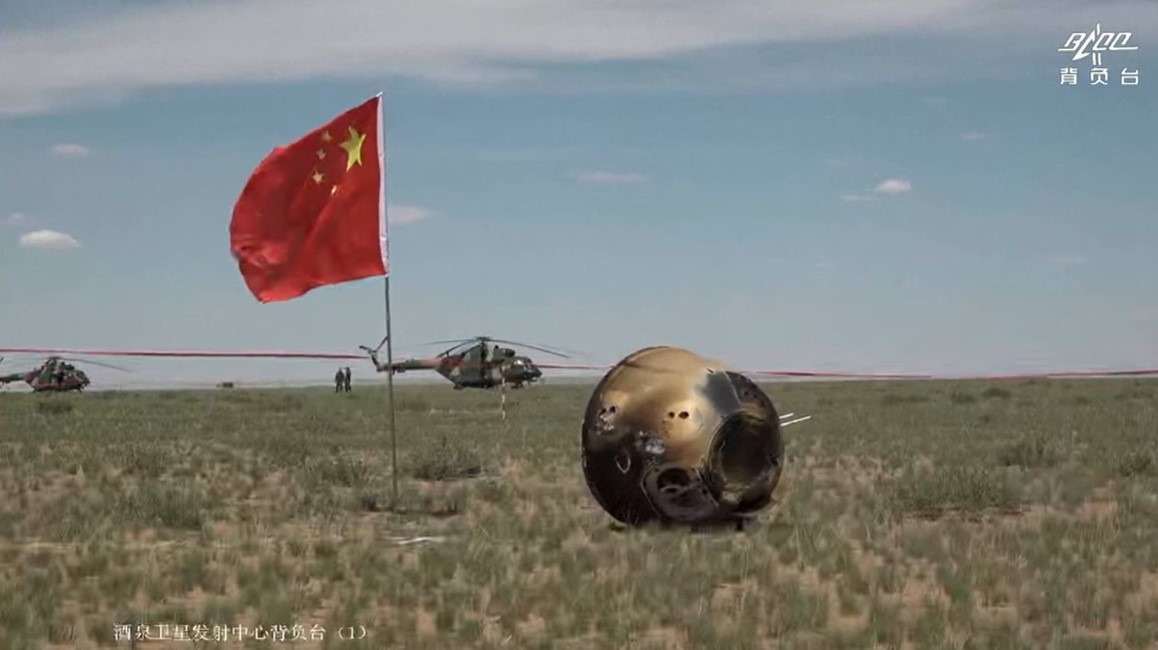HELSINKI — China is getting set for future deep space missions, having retrieved nearly two kilograms of lunar samples from the moon’s far side.
The Chang’e-6 reentry capsule landed back on Earth June 25, successfully ending a 53-day mission. The capsule was recovered as planned in grasslands of Siziwang Banner, Inner Mongolia.
The capsule was airlifted to Beijing and opened June 26 to retrieve the sample canister. The China National Space Administration (CNSA) announced Friday that it contains 1,935.3 grams of samples.
The mission aimed to collect up to 2,000 grams. The 2020 Chang’e-5 near side mission collected 1,731 grams. That mission encountered a drilling issue that impacted the amount collected.
The National Astronomical Observatories of Chinese Academy of Sciences will next unseal the sample container. NAOC will then prepare the samples obtained from drilling and surface retrieval, and pack them for storage.
It is expected that domestic scientific research institutions will be able to make applications for samples after six months. Samples will be opened to international applications two years later, according to CNSA regulations on lunar sample management.
Ge Ping, CNSA spokesperson, stated that the samples are stickier and more compacted than previous lunar samples.
South Pole-Aitken mysteries
It is hoped, according to a 2023 paper on the target landing area, that the samples will “address questions about the multiple lunar nearside–far side dichotomies and to provide new insights into both the early impact history of the Solar System and the geological evolution of the moon.”
“The samples collected from the South Pole-Aitken Basin may be very different from the samples collected from the front side, which is conducive to a more comprehensive understanding of the geological evolution history of the moon,” Li Chunlai, deputy chief designer of the Chang’e-6 mission, said, during a press conference in Beijing, June 27.
Just how revealing the samples will be remains to be seen. “There is no doubt that the return of the far side samples will yield unique insights to the nature of the moon’s evolution. And the fact that they just landed safely on Earth is a remarkable achievement for China,” Clive Neal, a professor and lunar scientist at the University of Notre Dame, told SpaceNews.
Neal notes however that the landing site is one of the oldest terranes on the moon. As such, material originating from the South Pole-Aitken basin impact—a vast basin created by a huge, ancient impact and of great scientific interest—is likely to be diluted, obscured and redistributed by later geologic processing.
“Whether they will unequivocally demonstrate the age of the South Pole Aitken basin or define the first mantle sample returned from the moon remains to be seen, but these samples will reveal secrets in the coming decades, just as the Apollo samples have done.”
Deep space missions ahead
CNSA officials stated Thursday that its second Tianwen mission is set to launch in 2025. Tianwen-2 is a combinted asteroid sample return and comet rendezvous mission. It is currently scheduled to lift off on a Long March 3B rocket in May 2025.
The mission will target near-Earth asteroid 469219 Kamoʻoalewa, collecting samples and returning to Earth around 2.5 years after launch. The spacecraft will deliver samples then head for main-belt comet 311P/PANSTARRS.
It was also reiterated that the third and fourth Tianwen missions will launch around 2030. These are the Tianwen-3 Mars sample return and Tianwen-4 Jupiter mission. The latter will, currently, include a solar-powered Jupiter orbiter and a smaller, radioisotope-powered spacecraft to make a flyby of Uranus.
Bian Zhigang, CNSA deputy administrator, said China will also implement major national science and technology projects and programs in the aerospace field. These include heavy-lift launch vehicles and reusable space transportation systems. Additionally, China aims to strengthen basic research, accelerate the research and development of key core technologies, and promote innovative development in space science, space technology, and space applications.
Next moon missions, cooperation
Next up for the moon, China is preparing for the Chang’e-7 lunar south pole mission expected to target Shackleton crater. It will be supported by the Queqiao-2 relay satellite which facilitated the Chang’e-6 mission.
CNSA published an announcement of opportunities in late 2023 for its 2028 Chang’e-8 lunar south pole mission. There are 200 kilograms of payload capacity for international cooperation. CNSA revealed Thursday it has received more than 30 letters of intent regarding collaborating on the mission.
It was also stated that CNSA has signed cooperation documents with more than 10 countries regarding the China-led International Lunar Research Station (ILRS). The countries were not named. SpaceNews reporting lists 10 countries in addition to China.
In response to a question on cooperation with the United States, Bian said the U.S. should remove hurdles. He noted the so-called Wolf Amendment in particular.
“If the U.S. side sincerely hopes to carry out normal space exchanges with China, it must take practical measures to remove the obstacles. As for China’s future space plans, they will be carried out at China’s own pace for peaceful use. We’re always eager to develop equal and mutually beneficial cooperation in an open and inclusive attitude,” Bian said.
